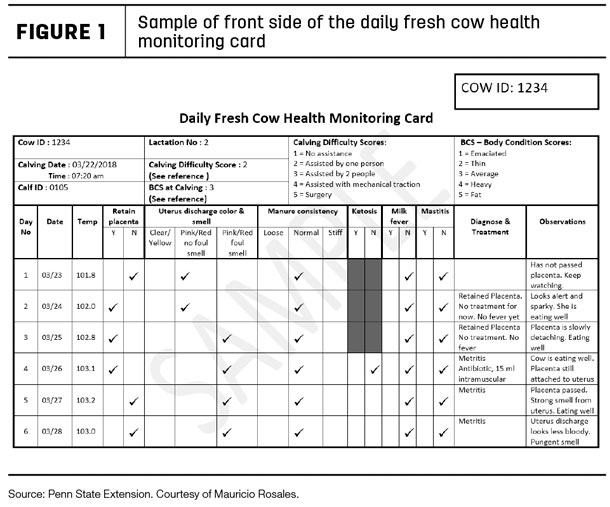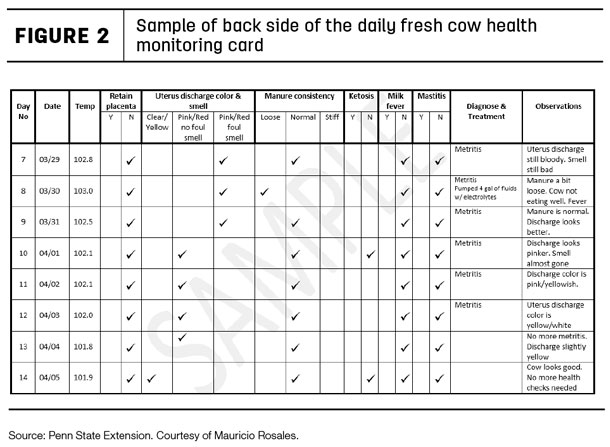Keeping accurate health and production records is an important practice that can help producers make meaningful decisions while troubleshooting transition cow issues in their operations.
If maintained correctly, these records can be a powerful tool to keep track of the herd’s progress. However, it might be difficult to implement a successful record-keeping system since many farmers tend to underestimate the value of this practice.
Particularly, keeping accurate and complete handwritten records might become challenging when there is a lack of resources or examples that can be used for farmers as a model to collect data in an organized manner.
Handwritten records still used
The National Animal Health Monitoring System has estimated that more than 70 percent of very small (fewer than 30 cows), small (30 to 99 cows) and medium (100 to 499 cows) size dairy farms in the U.S. use handwritten record systems.
Conversely, large farms (more than 500 cows) have adopted on-farm computer record-keeping systems. The implementation of computer-based record systems might be influenced by different factors such as financial limitations, herd size or religion. This last one may explain, at least in part, why there is still a large group of producers using paper-based systems.
The Plain sects are an important part of the dairy industry in the U.S. Almost all of these operations are small, family-based farms with traditional production systems. Because of their religious beliefs, these communities cannot implement technology; therefore, handwritten records appear to be their only on-farm record-keeping option.
Despite their special circumstances, these groups of producers still need to be competitive and have a simple but effective way to monitor health events and production in their operations.
On the other hand, while almost all large farmers use computer-based record systems, estimates indicate that 37.9 percent of these farmers also use handwritten records. This suggests that even with on-farm computer-based systems, large producers are still using paper-based records such as notebooks or ledgers.
Although production records are indeed key to evaluate and adjust different management practices in dairy operations, health records also can be used as an indicator of where to focus our efforts when dealing with a specific issue.
For instance, fresh dairy cows have a high risk of developing several health problems, and up to 30 to 50 percent experience metabolic or infectious illness during the transition period. Under these circumstances, it is critical to have an accurate record-keeping system to monitor the incidence of fresh cow diseases while assessing treated animal evolution and treatment effectiveness.
In addition to effectively monitoring animal health, a reliable health record-keeping system may be useful to decrease antibiotic use in animals and prevent antibiotic resistance. Currently, there are many public health concerns about the role of food animals in the surge of antibiotic resistance in humans.
Judicious antimicrobial stewardship in livestock operations is essential to decrease the risk of misusing these drugs in animals. Regardless of what type of record system is used, producers should implement a program that allows them to have an accurate and cautious management of antibiotics. The utilization of handwritten record systems should not be used as an excuse for poor antibiotic stewardship.
Data from a producer survey conducted in Iowa shows that 44 percent of the participants monitored the body temperature of post-fresh cows, while 28 percent performed health exams. Based on this survey, it can be estimated that several health parameters are assessed on a daily basis in this group of animals.
Normally, in conventional operations, all these data are transferred to an electronic system, such as on-farm computer record systems. However, for the Plain sects, that is not an option. Therefore, having a practical and easy-to-understand filing card may promote and facilitate the collection and monitoring of health records in this type of operation.
Resources for handwritten records
Since the industry is moving forward with advanced systems that reduce the utilization of handwritten records, there is a lack of available handwritten record methods or tools to collect and organize health data. Yet, a clear, practical and easy-to-understand health monitoring card could be beneficial for those producers who are still using paper-based records.
An individual daily fresh cow health monitoring card (Figures 1 and 2) was designed with the intention to provide an easy tool to collect health records at dairy operations. (This card is available in PDF format.)
Click on the images below to see them in more detail.
This card can be used to collect data and information for the diagnosis and treatment of the most common health disorders affecting fresh cows. Additionally, individual daily observations and treatments can be recorded for up to 14 days.
By appropriately using this card, veterinarians, owners, herd managers and consultants can quickly evaluate the status of a cow and recommend treatment or management alternatives without having to resort to the electronic records, which can be time-consuming.
In conclusion, regardless of the farm size or the limitations with the use of technology, almost all farmers still rely on handwritten records to monitor the health status of fresh cows in dairy operations.
Particularly, health records are important not only to keep track of the progress of individual animals, but also to monitor the performance of the herd and to decrease both antibiotic use and antibiotic resistance in dairy operations. Having an effective system that is easy to use and understand may better fit the farm logistics and may benefit producers and consultants.
The card presented herein would be an appropriate first step to start applying an accurate and reliable handwritten record-keeping system in your operation.
—Excerpts from Penn State Extension newsletter
References omitted but are available upon request. Click here to email an editor.








